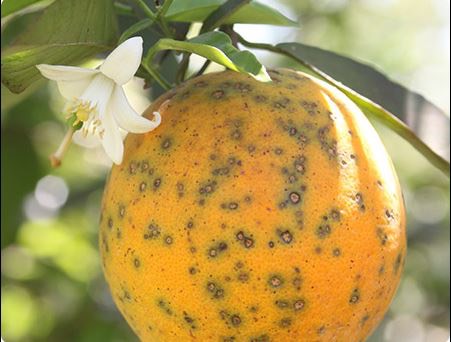
Position: Ph.D. Student
Office: 107
Office phone: + 49 4522 763-236
E-mail: vandresen[a]evolbio.mpg.de
Twitter: @desirrepetters
Research interests and current projects
Comparative genomics of Citrus-associated Phyllosticta species
Phyllosticta genus comprises several plant pathogenic species that are responsible for diseases symptoms such as leaf and fruit spots in many different hosts, as well as endophytic and saprophytic species. With the recent description of P. paracapitalensis and P. paracitricarpa, eight Phyllosticta are now known to be associated with Citrus hosts, either as pathogens or as endophytes, presenting different interactions and lifestyles. As this kind of variation in host-interaction within so closely related species exist, these Phyllosticta species provide a good model for evolutionary studies that aim to understand the evolution of phytopathogens, as well as obtain new targets for functional studies.
Although significant progress has been achieved in understanding the Phyllosticta genus, many questions still remain open. Even though pathogenic species have been described as causing Citrus Tan Spot, only P. citricarpa is regarded as the causative agent of Citrus Black Spot. These differences in biology and ecology of the citrus-associated Phyllosticta species have not yet been addressed from an evolutionary and genomic perspective. Such kind of approach could be useful in investigating and understanding the biological processes involved in the different associations that these species develop with citrus plants. Moreover, these analyses could help to detect possible species-specific adaptation and shared pathogenicity related traits between the Phyllosticta species, as well as unique features that could explain the pathogenicity of P. citricarpa.
As the genomes of the citrus-associated Phyllosticta species became available (with the exception of P. paracapitalensis), it is now possible to perform comparative analyses to understand functional and evolutionary differences between these species. Thus, the main goal of this project is to perform comparative genomic analyses for the citrus-associated Phyllosticta species, focusing on the evolution of pathogenicity-related mechanisms mainly for P. citricarpa. We are mostly interested in genome evolution and pathogenicity-genes evolution, with an emphasis on the identification of genome-wide patterns and signatures of positive selection between these closely related Phyllosticta species, and how these patterns could be related to the pathogenicity of P. citricarpa. Based in these genome analyses, we intend to further explore this topic through functional approaches involving gene deletion/silencing and transcriptome analysis, in order to validate the results and assess the involvement of positively-selected genes in pathogenicity. This project is conducted at MPI for Evolutionary Biology, under supervision of Prof. Eva Stukenbrock, in collaboration with Prof. Marcos Machado from IAC (Instituto Agronômico de Campinas, Brazil) and Prof. Pedro Crous (Westerdijk Fungal Biodiversity Institute).

Citrus sp. fruit showing the most common and characteristic symptoms of Citrus Black Spot disease: black lesions presenting pycnidia and surrounded by green halos. Source: FUNDECITRUS
Functional analysis in Phyllosticta pathogens
The development of new strategies for the control fungal phytopathogens may rely on functional approaches, which aim to understand and describe the molecular mechanisms involved in pathogenicity and virulence, as well as the host-pathogen interaction. Many functional analyses employ genetic transformation in order to investigate the function of specific genes or it's regulation mechanisms. Several methods are available, such as protoplast-mediated transformation, eletroporation and Agrobacterium tumefaciens mediated transformation (ATMT). In Phyllosticta citricarpa, ATMT using mycelium and spores allowed the construction of a transformant library and identification of candidate genes involved in picnidiospores production (Goulin et al. 2016). New goals in this project now include the deletion of the previously identified candidate genes, as well as obtention of new DsRed/GFP transformants, as well as optimizing a RNAi method for Phyllosticta citricarpa and other Citrus-associated Phyllosticta species. This project is conducted at BioGeMM (Bioprospecting and Molecular Genetics of Microrganisms lab) at UFPR, in Brazil, in collaboration with Prof. Marcos Machado from IAC.
Short CV
2018-current: PhD in Genetics, UFPR (Federal University of Parana, Brazil), under supervision of Prof. Chirlei Glienke. Sandwich-period from 2019-2020 in the MPI for Evolutionary Biology under Prof. Eva Stukenbrock supervision.
2016-2018: Master in Genetics, UFPR (Federal University of Parana, Brazil), under supervision of Prof. Chirlei Glienke
2011-2015: BSc in Biological Sciences, UFPR (Federal University of Parana, Brazil)
2008-2010: Technical Course on Computer Networks, SENAI (Brazil)
Publications
First Report of Colletotrichum nymphaeae Causing Blossom Blight, Peduncle Rot, and Fruit Rot on Pyrus pyrifolia in Brazil. Moreira RR, Vandresen DP, May-de-Mio LL, Glienke C (2019). Plant Disease. https://doi.org/10.1094/PDIS-12-18-2263-PDN
Identification of genes associated with asexual reproduction in Phyllosticta citricarpa mutants obtained through Agrobacterium tumefaciens transformation. Goulin EH, Savi DC, Petters DAL, Kava V, Galli-Terasawa L, Silva Jr. GJ, Glienke C (2016). Microbiological Research 192: 142-147. https://doi.org/10.1016/j.micres.2016.06.010